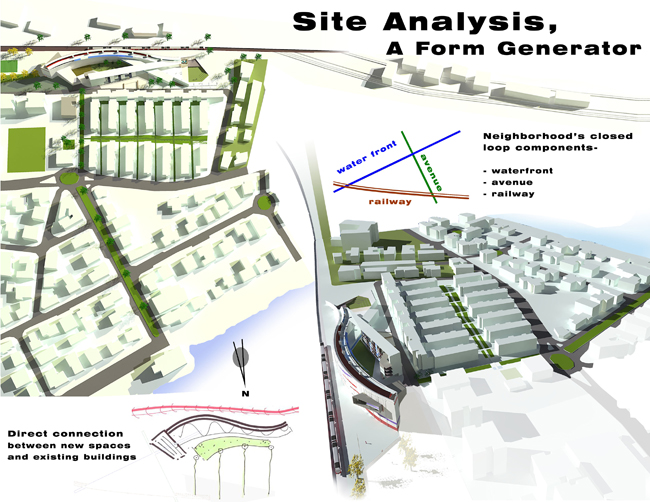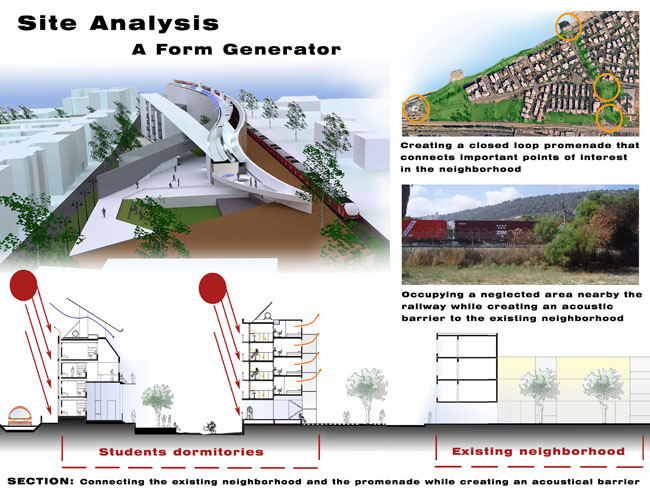|
|
| |
The Carbon Neutral Design Project: |
Carbon Neutral Teaching: Curriculum Materials Development |
Edna Shaviv and Abraham Yezioro
Faculty of Architecture and Town Planning | Technion - Israel Institute of Technology |
Combined “Solar Architecture” studio and theory courses - fourth year undergraduate elective distribution
Site Analysis/Site Design

Design Performance Objective |
Site Analysis - A Form Generator
The area of the site is a very unique one at the city scale. This is a triangle shaped area where sea, land and mountain meet (maybe the only place in the whole country). The triangle has a well developed waterfront promenade and a beautiful scaled tree avenue on two sides. The third side is adjacent to a neglected area caused by the presence of a railway. The project looks for developing this third side in order to complete the full cycle of the neighborhood, connecting with the promenade and the green avenue.
The proposed project creates by the opaque Trombe Wall an acoustical barrier to the existing neighborhood and the project itself facing its long façade towards the railway which is in the south orientation. As a result the main solar system proposed for this south façade is a trombe wall that allows heat gains in winter and is neutralized in summer. The cross ventilation is achieved through the same Trombe Wall that is opened only at the top to and through wind chimneys.
|
Student: xxx |
Software/Tools: |
|
|
Combined “Solar Architecture” studio and theory courses - fourth year undergraduate elective distribution
Site Analysis/Site Design
As
|
Investigative Strategy |
Use
|
Evaluation Process |
Present
|
|
Information about the Project and Studio |
• course outline
• project outline |
Evaluative Criteria |
|
Cautions |
|
Range of Applicability in terms of CLIMATE |
ALL |
Range of Applicability in terms of TYPE |
ALL |
Reference Material |
|
Duration of Exercise |
|
Degree of Difficulty / Previous Knowledge Required |
|
| |

Site Analysis - A Form Generator
Student Name
The area of the site is a very unique one at the city scale. This is a triangle shaped area where sea, land and mountain meet (maybe the only place in the whole country). The triangle has a well developed waterfront promenade and a beautiful scaled tree avenue on two sides. The third side is adjacent to a neglected area caused by the presence of a railway. The project looks for developing this third side in order to complete the full cycle of the neighborhood, connecting with the promenade and the green avenue.
The proposed project creates by the opaque Trombe Wall an acoustical barrier to the existing neighborhood and the project itself facing its long façade towards the railway which is in the south orientation. As a result the main solar system proposed for this south façade is a trombe wall that allows heat gains in winter and is neutralized in summer. The cross ventilation is achieved through the same Trombe Wall that is opened only at the top to and through wind chimneys.
|
|
| |
|
|

